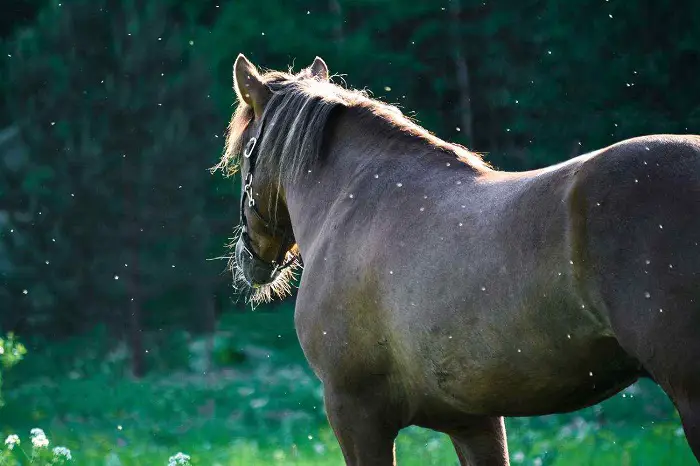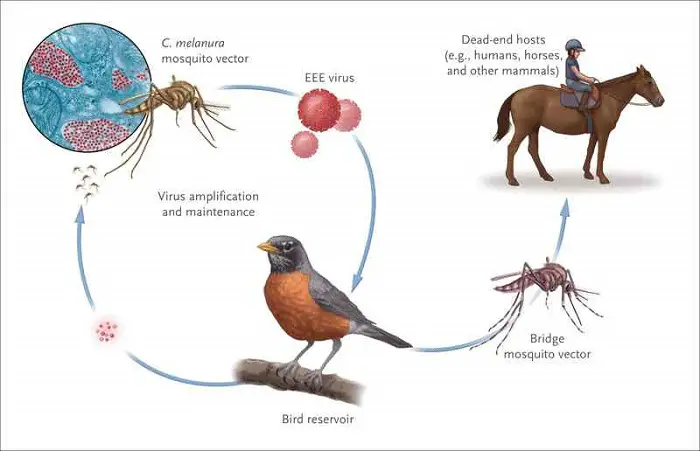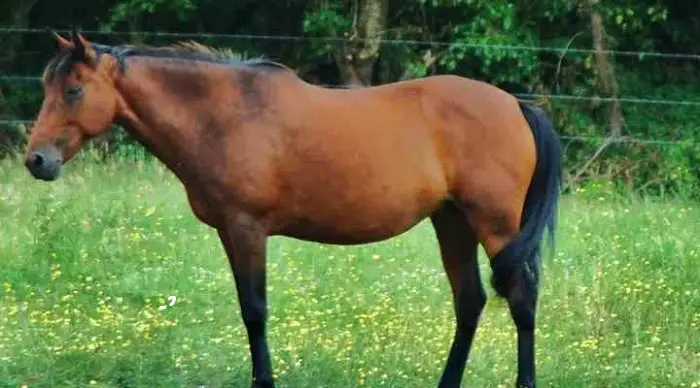Eastern equine encephalitis (EEE), or triple E, is a rare but severe mosquito-borne viral disease primarily affecting horses and humans. It is caused by the eastern equine encephalitis virus, which belongs to the family Togaviridae and the genus Alphavirus.
EEE is typically found in eastern regions of North America, particularly in the Atlantic and Gulf Coast states of the United States, as well as some parts of Canada, the Caribbean, and Central and South America. The virus is maintained in a transmission cycle between mosquitoes and birds, with certain mosquito species serving as the primary vectors.
When a mosquito infected with the EEE virus bites a human or a horse, the virus can be transmitted, leading to infection. While many individuals infected with EEE may not experience any symptoms, those who become ill often develop a severe illness characterized by encephalitis, inflammation of the brain.
Causes of Eastern Equine Encephalitis
Eastern equine encephalitis (EEE) is caused by the eastern equine encephalitis virus (EEEV), a member of the Alphavirus genus in the family Togaviridae. The virus is primarily transmitted through the bite of infected mosquitoes.
The transmission cycle of EEE involves mosquitoes and birds. Mosquitoes, particularly species belonging to the Culiseta and Coquillettidia genera, serve as the primary vectors for the virus. These mosquitoes become infected by feeding on infected birds, which act as reservoir hosts for the virus. The virus can replicate within the mosquito, and subsequent mosquito bites can transmit the virus to other birds, horses, and humans.
In some cases, humans and horses can become “dead-end” hosts, meaning they do not develop enough levels of the virus in their bloodstream to infect mosquitoes. However, they can still experience severe illness due to the direct effects of the virus on their central nervous system.
Transmission of EEE
Equine encephalitis is primarily transmitted through the bite of infected mosquitoes. Mosquitoes serve as vectors for the virus and play a crucial role in the transmission cycle.
When a mosquito feeds on an infected reservoir host, such as an infected bird or, in the case of EEE, an infected horse, it acquires the virus. The virus replicates within the mosquito, eventually reaching its salivary glands. Once the mosquito is infected, it can transmit the virus to other susceptible hosts through subsequent blood meals.
When bitten by mosquitoes, humans and horses can become infected with equine encephalitis viruses. The virus enters its bloodstream through the mosquito’s saliva. It should be noted that direct contact with infected animals or their tissues does not typically transmit the virus.
Epidemiology of Eastern Equine Encephalitis
EEE is primarily found in regions of North America, particularly in the Atlantic and Gulf Coast states of the United States. However, sporadic cases or outbreaks have also been reported in other parts of the United States, as well as in Canada, the Caribbean, and Central and South America.
EEE is considered a rare disease, with a relatively low incidence compared to other mosquito-borne illnesses. However, it is a severe and potentially fatal infection. The incidence of EEE varies from year to year, and outbreaks can occur in specific geographic regions during certain seasons.
The transmission cycle of EEE involves mosquitoes and birds, with humans and horses being incidental hosts. The virus is primarily maintained in a bird-mosquito-bird cycle, where infected mosquitoes bite infected birds, allowing the virus to replicate and spread. Certain mosquito species, such as Culiseta melanura, are significant in this cycle.
Humans and horses can become infected when bitten by infected mosquitoes, but they do not contribute significantly to the transmission cycle. Instead, they can experience severe illness, including encephalitis, if infected.
The risk of EEE infection is highest in areas with favorable conditions for mosquito breeding, such as wetlands and swampy areas. The risk is typically most significant during the warm months when mosquito populations are high. Local health departments and agencies monitor mosquito populations and conduct surveillance for EEE and other mosquito-borne diseases to assess the risk and implement appropriate control measures.
Clinical Signs of Eastern Equine Encephalitis
Eastern equine encephalitis (EEE) can cause clinical signs and symptoms in affected individuals, including humans and horses. The severity of the illness can vary, but EEE is known to be a potentially severe and often fatal disease.
In humans, the incubation period of EEE is typically 4 to 10 days after being bitten by an infected mosquito. Many individuals infected with EEE may not experience symptoms (asymptomatic infections). However, when symptoms do occur, they often manifest abruptly and can include:
- Fever: High fever, often exceeding 103°F (39.4°C), is a common symptom of EEE.
- Headache: Severe headaches are frequently reported and can be persistent and intense.
- Encephalitis: EEE causes inflammation of the brain (encephalitis). Symptoms related to this inflammation may include:
- Stiff neck: Neck stiffness and pain, especially when touching the chin to the chest.
- Altered mental status: Confusion, disorientation, irritability, restlessness, or drowsiness.
- Seizures: Some individuals may experience seizures.
- Behavioral changes: Personality changes, mood swings, or irritability.
- Sensory disturbances: Sensitivity to light (photophobia) and sound (phonophobia).
- Paralysis: In severe cases, paralysis or weakness may occur.
- Coma: Some individuals may progress to a comatose state.
In horses, EEE can cause similar symptoms as in humans, including fever, neurological signs, and encephalitis. Horses may exhibit behavioral changes, depression, lack of coordination, muscle twitching, weakness, seizures, and difficulty swallowing. The mortality rate in horses affected by EEE can be as high as 90%.
Diagnosis of Equine Encephalitis
The diagnosis of equine encephalitis, including Eastern equine encephalitis (EEE), involves a combination of clinical evaluation, laboratory testing, and epidemiological factors. Prompt and accurate diagnosis is crucial for appropriate management and control measures. Here are the critical components of diagnosing equine encephalitis:
- Clinical Evaluation: A thorough assessment of the horse’s clinical signs and symptoms is essential. These may include fever, neurological abnormalities (incoordination, muscle weakness, seizures, and behavioral changes), and signs of encephalitis.
- History and Epidemiological Factors: Information about the horse’s travel history, potential exposure to mosquitoes, and knowledge of equine encephalitis in the region can aid in the diagnostic process.
Laboratory Testing:
- Blood Tests: Blood samples can be collected to evaluate the presence of antibodies against the specific equine encephalitis virus. This is typically done using serological tests, such as enzyme-linked immunosorbent assay (ELISA) or virus neutralization tests.
- Cerebrospinal Fluid (CSF) Analysis: If neurological signs are present, collecting CSF through a spinal tap can help assess inflammation and identify the virus.
- Virus Detection: In some cases, molecular tests, such as polymerase chain reaction (PCR), can be performed on blood or CSF samples to detect the presence of the viral genetic material directly.
Necropsy: If the horse dies or is euthanized due to severe illness, a necropsy (animal autopsy) may be performed to examine the brain and other tissues. This can help identify characteristic pathological changes associated with equine encephalitis.
Differential Diagnosis of Equine Encephalitis
The clinical signs and symptoms of Eastern equine encephalitis (EEE) can overlap with other diseases, particularly other forms of viral encephalitis. Therefore, it is crucial to consider a range of differential diagnoses when evaluating a suspected case of EEE. Some of the critical differential diagnoses for EEE include:
- West Nile Virus (WNV) Encephalitis: WNV is another mosquito-borne virus that can cause encephalitis. It shares some similarities with EEE in terms of clinical presentation. EEE and WNV can cause fever, headache, neurological symptoms, and encephalitis. Laboratory testing is needed to distinguish between the two.
- St. Louis Encephalitis (SLE): SLE is another viral encephalitis transmitted by mosquitoes. It can cause similar symptoms to EEE, including fever, headache, and neurological manifestations. Laboratory testing is necessary to differentiate between SLE and EEE.
- Herpes Simplex Virus (HSV) encephalitis is a common cause of viral encephalitis. It can present with fever, headache, altered mental status, and seizures, similar to EEE. However, HSV encephalitis often has a more prolonged and subacute course. Laboratory tests, including PCR and CSF analysis, are crucial for diagnosing HSV encephalitis.
- Other viral encephalitides: Several other viruses can cause encephalitis, such as California encephalitis virus, La Crosse virus, and Powassan virus. These viruses have overlapping symptoms with EEE; laboratory testing is necessary to differentiate them.
- Bacterial Meningitis: Bacterial meningitis, caused by Streptococcus pneumoniae or Neisseria meningitidis, can present with symptoms similar to viral encephalitis, including fever, headache, neck stiffness, and altered mental status. Clinical evaluation, CSF analysis, and bacterial cultures can help differentiate bacterial meningitis from EEE.
- Non-infectious Causes: There are non-infectious causes of encephalitis-like symptoms that should also be considered, such as autoimmune encephalitis, metabolic disorders, and toxic exposures.
Treatment of Equine Encephalitis
Treatment for equine encephalitis, including Eastern equine encephalitis (EEE), primarily focuses on supportive care, as no specific antiviral treatment is available for these viral infections. The primary goals of treatment are to manage symptoms, provide appropriate nursing care, and support the affected horse’s overall well-being. Here are some critical aspects of the treatment approach:
- Hospitalization: Horses with suspected or confirmed equine encephalitis may require hospitalization for close monitoring and supportive care. A quiet, comfortable environment can minimize stress and facilitate the horse’s recovery.
- Symptomatic Management: Treatment aims to alleviate the symptoms and complications of equine encephalitis. This may include administering medications to control fever, reduce inflammation, manage pain, and control seizures if they occur.
- Fluids and Nutrition: Intravenous fluids may be provided to maintain hydration and electrolyte balance, especially if the horse is not eating or drinking adequately. Ensuring proper nutrition through enteral or parenteral routes supports the horse’s overall health and recovery.
- Neurological Support: Horses with neurological symptoms may require careful monitoring and supportive care to manage their needs. This may involve providing a padded stall to prevent injury, assisting with mobility, and addressing complications such as difficulty swallowing or respiratory distress.
- Wound Care: If the horse has wounds or injuries due to unsteady gait or self-inflicted trauma, proper wound management and infection control measures should be implemented.
- Preventing Secondary Infections: Horses with equine encephalitis are vulnerable to secondary infections due to compromised immune function. Steps should be taken to minimize the risk of bacterial or fungal infections, such as maintaining good hygiene, proper wound care, and prompt treatment of any signs of infection.
Prevention and Control of EEE
Prevention and control measures for Eastern equine encephalitis (EEE) primarily focus on reducing mosquito populations, minimizing mosquito exposure, and implementing horse vaccination strategies. Here are fundamental approaches to prevent and control EEE:
- Mosquito Control:
- Eliminate Mosquito Breeding Sites: Reduce standing water sources, such as stagnant pools, containers, and discarded tires, where mosquitoes lay their eggs. Regularly empty and clean containers that can collect water.
- Larvicides: Apply larvicides to standing water sources that cannot be eliminated to prevent mosquito larvae from developing into adults.
- Adult Mosquito Control: Implement mosquito control measures such as insecticide spraying and fogging in areas with high mosquito activity.
- Personal Protection:
- Use Mosquito Repellents: Apply Environmental Protection Agency (EPA)-approved mosquito repellents on exposed skin and clothing when outdoors. Follow the product instructions for safe and effective use.
- Wear Protective Clothing: Cover exposed skin with long-sleeved shirts, long pants, socks, and shoes.
- Avoid Peak Mosquito Activity: Minimize outdoor activities during dawn and dusk, when mosquitoes are most active.
- Vaccination of Horses:
- Consult a Veterinarian: Work with a veterinarian to develop a horse vaccination plan. Vaccination against EEE is available and is typically administered annually or as the veterinarian recommends.
- Vaccinate Horses Early: Ensure horses are vaccinated well before the peak mosquito season to allow sufficient time for the development of immunity.
- Surveillance and Reporting:
- Animal Disease Reporting: Report any suspected equine encephalitis cases to local veterinary authorities or animal health agencies. This helps monitor the disease’s spread and implement appropriate control measures.
- Public Awareness and Education:
- Promote Awareness: Educate the public, horse owners, and communities about EEE, its symptoms, and preventive measures.
- Community Efforts: Encourage community participation in mosquito control activities, such as eliminating breeding sites and implementing personal protective measures.
Concluding Remarks on Eastern Equine Encephalitis
Eastern equine encephalitis (EEE) is a severe viral infection that affects humans and horses. It is primarily transmitted through mosquito bites, with mosquitoes serving as the vectors for the virus. EEE can cause severe neurological symptoms, including encephalitis, and has a high fatality rate in humans and horses.
Prevention and control efforts for EEE focus on reducing mosquito populations, minimizing exposure to mosquitoes, implementing vaccination strategies for horses, and promoting public awareness. Mosquito control measures, such as eliminating breeding sites and using larvicides and adult mosquito control methods, can help reduce the mosquito population. Personal protection measures, including mosquito repellents and protective clothing, are essential to minimize mosquito bites.
Vaccination of horses against EEE is a crucial preventive measure, and horse owners should consult with veterinarians to develop a vaccination plan. Early and regular vaccination can help protect horses from the disease.
Public awareness and education play a significant role in EEE prevention. By promoting awareness about EEE, its symptoms, and preventive measures, individuals can take necessary precautions to reduce their risk of infection.
It is important to note that EEE is a rare but potentially life-threatening disease, and any suspected cases should be promptly reported to the appropriate health authorities or veterinary agencies. Timely diagnosis, supportive care, and management of symptoms are essential in treating EEE.
Continued surveillance, research, and collaborative efforts are necessary to understand better and control Eastern equine encephalitis and other mosquito-borne diseases. By implementing preventive measures and staying informed, we can work towards reducing the impact of EEE on human and animal health.



